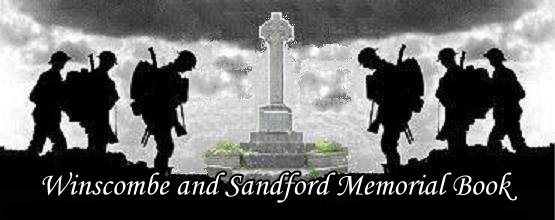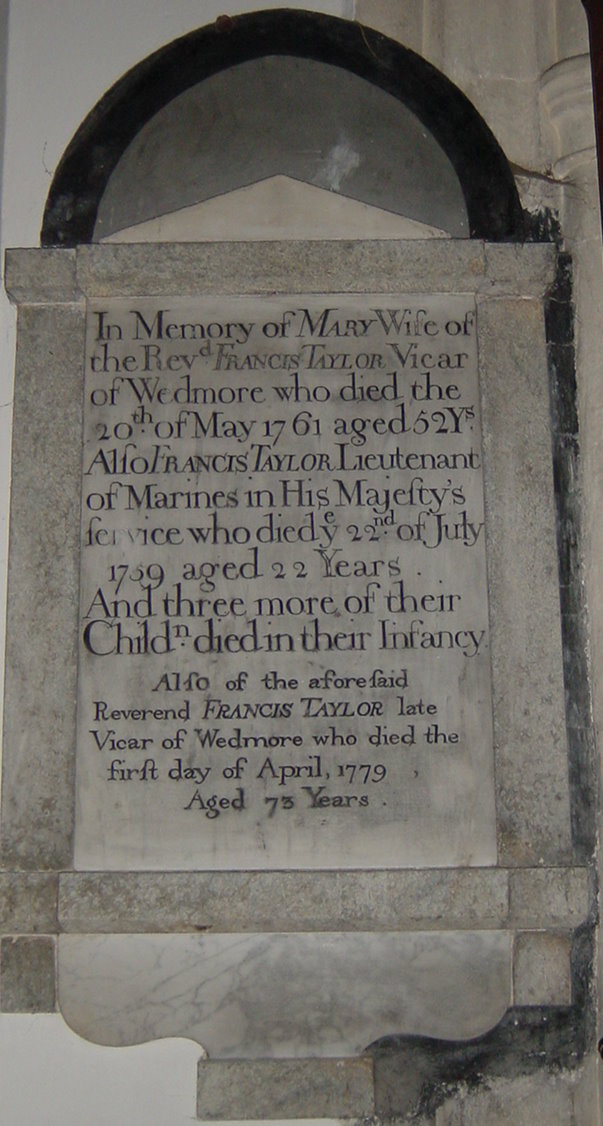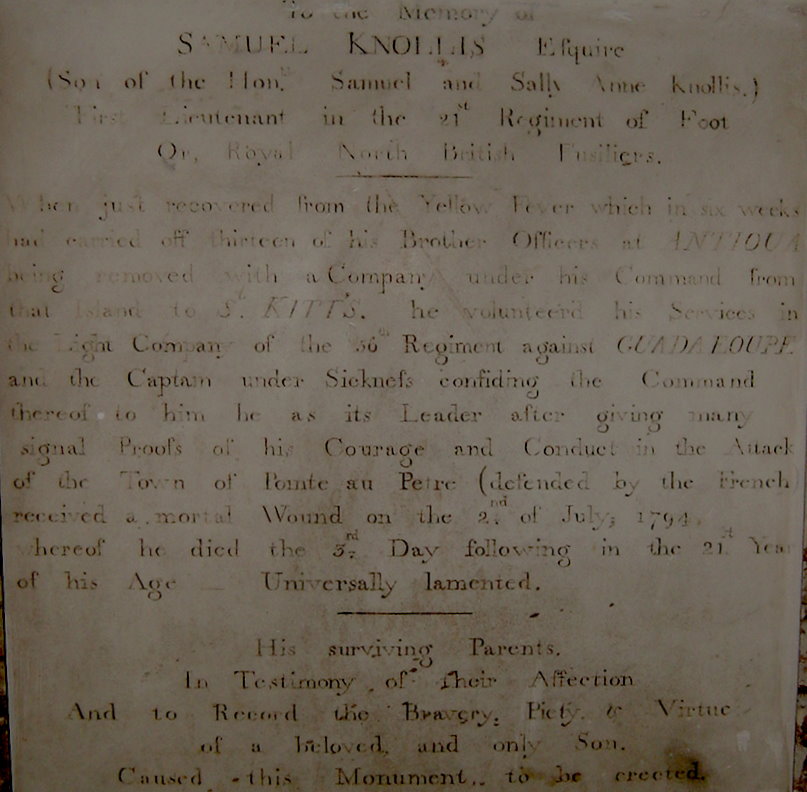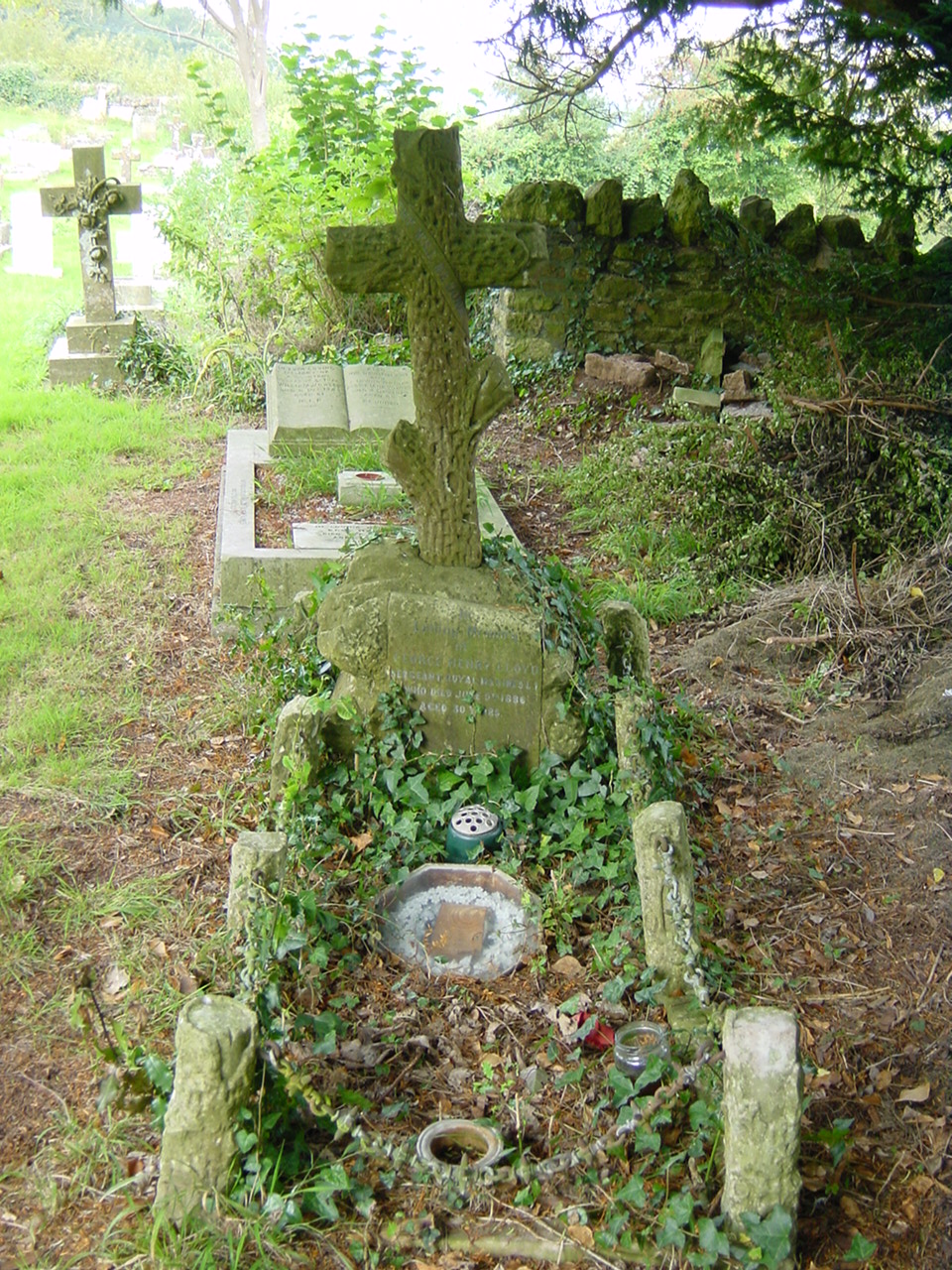
A few soldiers from earlier wars are also honoured in St James :
The earliest is Lieutenant of Marines, Francis Taylor [died 22/7/1759] on this plaque in the Choir, by the organ;

While more research needs to be done, it is likely that Lt Taylor fell at the Siege of Fort Niagra fighting against the French during the “Seven Years War”. The Fort was finally taken of 25th July 1759 and remained in British hands for the next 37 years until ceded to the United States of America where it is still preserved today.
In the bell tower - where the new Vestry Room roof blocks any view - are two plaques remembering a Father and Son, both having the same name and both having served in the Army : Samuel Knollis. There are further Knollis’ family plaques on the south wall of the Nave and in the Bell tower
The Father is Colonel, The Honourable, Samuel Knollis, [died 30/7/1819] He did not die in battle but his son, his service is interesting so what we know is given here. He was born in 1740, the younger brother of the 6th Earl of Banbury, he seems to have had a long military career, the earliest reference to him is at the Battle on Minden [Seven Years’ War 1st August 1759] when he would have been about 19 years old.
This is the reference in the Burkes Peerage the extract from entry for the Fellowes familly: William {Fellowes}... was a surgeon's mate in the Coldstream Regiment of Foot Guards. In this regiment he fought at the Battle of Minden in 1759. According to his son, "he and his old friend, the late Colonel Samuel Knollis, were the last survivors of the engagement - despite suffering a distinct handicap... William and his compatriots had been washing their shirts when they were surprised by the enemy - and had little option but to fight in wet linen". This is perhaps not wholly accurate as the Coldstream Regiment of foot Guards were present at Minden which was a planned attack at first light with the British infantry marching out to attack the French; so it is unlikely that any British soldiers were surprised washing their shirts.
One further piece of evidence of Samuel Knollis’s career does survive in Somerset: That is the passports issued to him after the recapture of Minorca on 4th February 1782 by elements of the combined Spanish and French army. Captured after the nine month siege of Fort St Phillipe, the passports; still held in the Somerset county archives in Taunton; were issued to (at that time), Major Knollis, his wife, children and servants, when he was paroled and allowed him safe passage to return to England.
Samuel senior died at the age of 79 and is buries at St James’s with his wife, Sally Ann, in her family vault. His Son had followed him into the King’s service but did not live to a ripe old age.

The Colonel’s son, First Lieutenant Samuel Knollis [died 5 July 1794] would have been 9 years old when the combined French and Spanish army finally captured Fort St Phillipe. The siege does not seem to have put him off the army life, he joined the 21st Regiment of Foot, Royal North British Fusiliers - a long established Scottish regiment which was reconstituted in 1782 after being virtually dormant since being at the surrender of Saratoga in 1777 during the American War of Independence
His plaque in the Bell Tower tells the story of his death [paraphrased here]:
When just recovered from the yellow fever, which in six weeks had carried off 13 of his brother officers, he was despatched in command of a company from Antigua to St Kitts. There he volunteered, due to the sickness of the Captain in charge, to command a company of the 56th (the West Essex) Regiment of Foot. He led his Company against the French at Guadeloupe with courage and good conduct while attacking the French held town of ‘Pointe au Petre’ [the largest town on the main island of the five in the archipelago which make up Guadeloupe ]. During the attack he received a fatal wound on 2/7/1794 and died 3 days later, at the ago of 21.
Guadeloupe has been fought over many times by the British and French. The French took possession of the island in 1635 and it was annexed to the kingdom of France in 1674. Over the next century, the island was seized several times by the British. One indication of Guadeloupe's prosperity at this time is that in the Treaty of Paris (1763), France, defeated in war, abandoned its territorial claims in Canada in return for British recognition of French control of Guadeloupe.
In an effort to take advantage of the chaos ensuing from the French Revolution, Britain attempted to seize Guadeloupe in 1794 and held it from April 21 to June 2. If the reported date of Samuel’s death is correct it indicates his attack did not succeed in taking control of the town. The French retook the island under the command of Victor Hugues
On February 4, 1810 the British once again seized the island and held it until March 3, 1813, when it was ceded to Sweden as a consequence of the Napoleonic Wars. Sweden already had a colony in the area and only a year later Sweden ceded the island to France in the Treaty of Paris of 1814. Today It is still a French département d'outre-mer .
In the Churchyard is the grave of George Henry Lloyd, Sergeant Royal Marines Light Infantry Died June 9th 1886 30yrs. We have no information about him . The box on the grave appears to be a presentations from other Sergeants of the Royal Marines [the wooden “scroll” inscription having all but faded away] but may well indicate he was on active service or an active “veteran” when he died.

Just to the East of the Porch in is a stained glass window and plaque dedicated to the memory of Montague Beadon Follet [d 7th July 1900]


Montague Beadon Follett was born 1875 in Winscombe, his father, Richard, was the vicar at St James. He left Winscombe in his early 20’s and became a Coffee Planter at Nungangode Estate, Mysore, India. At the outbreak of the Second Boer War he enlisted as a Trooper in 'B' Coy, 3rd Section of Lumsden's Horse, a volunteer corps of mounted infantry raised in India.
Montague arrived in South Africa with his corps in February 1900 seeing action at Bloemfontein, Pretoria and Johannesburg when the British army besieged and took the major Boer cities. He died from Enteric fever {Typhoid} in hospital at Johannesburg on the 7th July 1900. More British soldiers died from disease than were killed in action during the 2nd Boer War, the Army providing its own men with the same unsanitary conditions, food and water that also decimated the Boer and local populations kept in concentration camps.
Montague's younger brother also volunteered for Lumsden's Horse, surviving the 2nd Boer War and going on to become became Lt-Col. Francis B. Follett, DSO, MC (Royal Warwickshire Regt) - his name being recorded on the Triptych as one of the men of Winscombe who returned home from the Great War and it was one of his five sisters who seconded the proposal to move the Great War Triptych to the St James’s church porch in 1921.
Recently Montague’s “Queen’s South Africa Medal” [the general service medal issued to all British and commonwealth troops serving in the 2nd Boer war] was sold by a Gloucestershire medal dealer for £475.